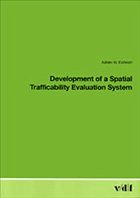For a long time the use of fully mechanized systems for timber harvests has been limited to terrain that can accommodate vehicular locomotion. In textbooks, the two threshold values that normally separate trafficable from non-trafficable zones are a slope of 25 to 35% and a soil strength >480 kPa. However, in areas such as Switzerland these two parameters are too rough to determine accurate limits.
Therefore, the following questions arise when planning for timber harvests:
- Is it possible to analyze and spatially describe soil-mechanical properties, especially water content and soil bearing capacity?
- Which areas are trafficable at harvesting time?
- How does one visualize the results in maps?
The Trafficability Evaluation System (TES) presented here provides necessary support when planning machine employment and optimizing the harvesting operation layout. The prototype for TES now consists of three elements (model base, database, and user interface) and is fully integrated into ESRI's GIS environment. Its design follows the classical approach toward SDSS.
TES was evaluated in the research forest of the ETH in Fall 2000.The study demonstrated that TES provides acceptable accuracy in predicting spatio-temporal variability in water content and soil strength when compared with standard models of technical vehicle mobility. The presumed relationship between water content and soil bearing capacity has also been confirmed. In examining the plausibility of different mobility models, it became apparent that no single model is perfectly suited for all Swiss soil types. Therefore, the advantage of TES is further shown in that the user can select not only the appropriate vehicle/tire parameters but also the specific mobility model.
In summary, evaluating trafficability using only static criteria, e.g. slope gradient, to determine locomotion limits is a simple approach that usually will not fit actual field conditions. In the future, therefore, modellers should express trafficability in dynamic terms that are a function of terrain, soil bearing capacity, and vehicle configuration.
Therefore, the following questions arise when planning for timber harvests:
- Is it possible to analyze and spatially describe soil-mechanical properties, especially water content and soil bearing capacity?
- Which areas are trafficable at harvesting time?
- How does one visualize the results in maps?
The Trafficability Evaluation System (TES) presented here provides necessary support when planning machine employment and optimizing the harvesting operation layout. The prototype for TES now consists of three elements (model base, database, and user interface) and is fully integrated into ESRI's GIS environment. Its design follows the classical approach toward SDSS.
TES was evaluated in the research forest of the ETH in Fall 2000.The study demonstrated that TES provides acceptable accuracy in predicting spatio-temporal variability in water content and soil strength when compared with standard models of technical vehicle mobility. The presumed relationship between water content and soil bearing capacity has also been confirmed. In examining the plausibility of different mobility models, it became apparent that no single model is perfectly suited for all Swiss soil types. Therefore, the advantage of TES is further shown in that the user can select not only the appropriate vehicle/tire parameters but also the specific mobility model.
In summary, evaluating trafficability using only static criteria, e.g. slope gradient, to determine locomotion limits is a simple approach that usually will not fit actual field conditions. In the future, therefore, modellers should express trafficability in dynamic terms that are a function of terrain, soil bearing capacity, and vehicle configuration.

